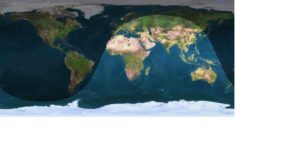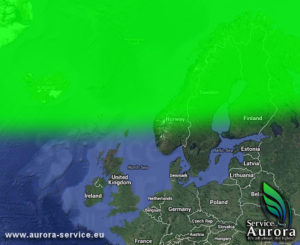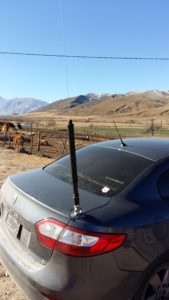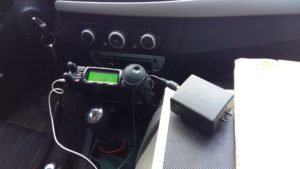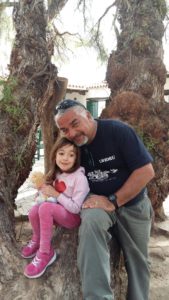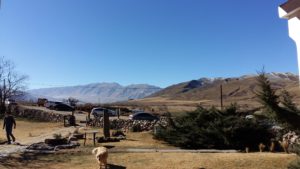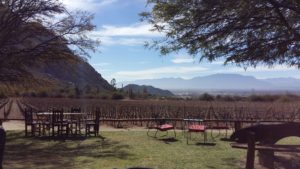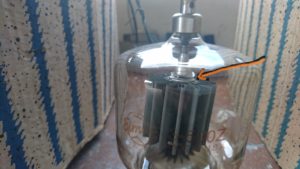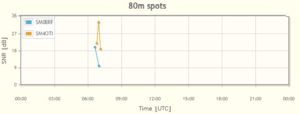2017 December 24
Greyline to Japan. Around winter solstice there is a very good path to JA in our mornings.
Worked JA8EAT with 599/599 on 80 m.
2017 December 23
How big are the losses when using military telephone cable as an antenna wire?
A 14 MHz dipole was erected and the extra losses as compared to copper were measured for telephone cable and an 1 mm steel wire.
My measurements suggest 0.85 dBs extra loss for the telephone cable and 2.3 dBs for the steel wire.
Details can be find under “Antenna projects”:
Military telephone cable as the antenna wire. How big are the losses?
2017 December 8
A good morning with 5W1AS and ZL2RX and PY on 40m. In the evening 160 was fair. QSO with BD4WN. 80m was good also and QSO with W1MK. Rob was best on my 2 el wire Yagi set for JA and not on the dipole for NW/SE!
Recording of part of the contact:
The numbers: SFI:70 A:5 k:1
2017 December 6
Tried 160 last night but very weak DX signals so went to 80. Worked VK3CWB who had a signal hitting the S9 mark on my TX antenna. He was best on my dipole with one leg almost horisontal facing SE/NW and one leg almost vertical. Local noise seems to increase every year. Now at S7 to S8 with new rattle. The noise on the bevs are about S1 but signals tend to be about 10 dBs weaker on the bevs compared to the TX antennas on 80.
Recording of the QSO:
Aurora was quite close:
2017 December 3
Low bands were good last night. Worked VO1HP on 160 with good signals. I was surprised he could hear me so well. I was using the top loaded 28 m vertical (tower with Yagies). There are very few ground radials in that direction and very poor ground with a slight uphill slope for 150 meters. VOACAP suggested 26 dgs elevation angle for best signal at that time. So that’s probably the reason. On 80 on the other hand the best angle is 6 dgs resulting in mediocre signal in NA at that time of the day. Could not hear him on the TX antenna. Too much local noise. Very good signal on the NW bev, readable on the SW and nothing on the new NE terminated wire.
Moved to 80 and worked JA7BXS who was S8. Readble on the 2 el wire Yagi and very good both on the SW unterminated bev and the NE bev. Readable on the NW wire.
Recording of Takar JA7BXS. Starting with the NE bev, switching to the SW after a few seconds, the TX antenna (noisy) in the middle back to the SW wire and the NE bev at the very end:
Called DU3LA for quite a while, but he didn’t hear me. Worked mostly JAs but also a R3-station and SM6NOC. He was slightly better on the SW unterminated wire than on the new NE bev.
2017 November 27
Today I lengthened the NE (65 dgs) beverage. It’s now 130 m long and terminated. The 180 m unterminated SW wire is still almost as good to the NE. To the SW there seems to be 15 dBs weaker signal than on the SW wire on 80 m.
2017 November 20
Midnight local time
At last J5T had a not so strong but Q5 signal on 160m. He came back on first call. I nearly fell of my chair.
2017 November 17
J5T calling JA on 160m around JA SR 2130Z.
Signals tend to deteriorate each evening when time for Europe later.
2017 November 15
I was listening on VK9MA on 80 m CW after our sunset. Was surprised to find the best signal shifted between my different beverage wires, that is the NW (120m), WNW (180m) and NE (100m) wires. All were unterminated. The signal had rather deep QSB and the biggest difference was between the NW wire and the other two. It’s signal was several S-units better at times.
My guess is changing polarisation of the incoming signal. The NW wire has horizontal polarization towards VK9MA and the two others have vertical polarization.
2017 November 13
Today I performed a common mode measurement on a military telephone cable called DL1000 in Sweden. It was made on a 50 m length and the common mode rejection was 25 dBs on 7 MHz and 40 dBs on 3.5 MHz.
See “Antenna projects” for details.
2017 November 12
Today I measured the attenuation of a 50m stretch of DL1000 military telephone cable. It varies from about 2 dBs at 1,8 MHz to about 5 dBs at 7 MHz.
See “Antenna projects” for details.
2017 November 8
Today a new NE Beverage wire was put in place replacing the old broken 90 m wire pointing at 40 dgs. The new wire is 100 m long at the moment pointing at 65 dgs and unterminated. The plan is to increase that to 150 m and put a termination in place.
There was also a new grounding stake at the hub.
Was listening to VK9MA on 80 and could not hear any difference between the new wire and the old WSW unterminated 185 m long wire.
2017 November 5
Mellish Reef, VK9MA. Big signal on 80 CW. S7 on an Inv vee dipole.
——————————————–
The naughty dog has digged up and chewed on the Beverage feeding line again today :-(. I have now sprayed citrus water on the whole stretch. Hope it helps.
2017 October 18
The feeder and control line is now repaired and kerosene is dripped on the ground along the whole stretch of the cable. Will be interesting to see if the dog dislikes the taste.
I was watching my signal on a SDR in ZL around New Zealand sunrise.
Nothing on 160m
25 dBs above noise on 80m
20 dBs on 40m
and 10 dBs on 30m.
At the same time S57V was 40 dBs above noise floor on 30!
The figures:
SFI = 70, A = 6, k= 0
Which would indicate fairly good propagation. True for 80 but definitely not on 30m from here.
2017 October 17
Today when I was to look for ZL on TB at their sunrise and switched in the beverage system there was a big silence. Not the slightest noise. Went out in the dark with a headlamp and 100 meters into the wood a dog had digged up a two meter length of the UTP feeder and chewed on it 🙁 .
Earlier today I performed some measurements on the tribander regarding Front to Back ratio and also the 3 dB points on 10 m.
The findings:
QRG kHz F/B dB
14045 13
14085 > 30
14150 > 30
14200 11
21001 23
21100 13
21200 8
28001 2
28150 >13
28200 >13
28500 13
The 3 dB points for the main lobe on 28500 kHz were 65 degrees apart. Same on 20m but less on 15m.
2017 October 15
Today the rebuilt radiator for the tribander was put in place. The traps were removed and there is now a full size dipole for 20 m made of aluminium from scrapped tubing. For 15 m there is a wire dipole erected 15 cm above the 20 m dipole and fed with a pair of copper wires. The dipole for 10 m is another 15 cm up and fed with 400 ohm ladder line. All dipoles are connected to the common original voltage balun from the FB-53.
The whole device was adjusted for resonance at a height of about 5 meters with a MiniVNA PRO connected via Bluetooth to my Android phone.
When the radiator was in place it was swept from the shack with the length of the feeder (34.5 meters) removed. The most spectacular change was for the 20 m dipole. It was set for minimum SWR at about 14050 kHz. When in place in the beam the frequency for minimum SWR had moved to 14650 kHz and resonance was now at 14350 kHz. When I measured the length of the dipole at ground it was 2×5.0 m and not 2×5.2 m as I had simulated for a similar three element beam. But I didn’t believe it would change that much. The SWR is acceptable at the band edge so won’t take it down to change the length.
The 15 and 10 meter dipoles didn’t change that much but the overall SWR on 15 is on the high side all over the band.
SWR numbers:
1.86:1 at 14000 kHz falling to 1.60:1 at 14350 kHz with a minimum of 1.44:1 at 14650 kHz
1.54:1 at 21000 kHz rising linearly to 3.10:1 at 21300 kHz
1.67:1 at 28000 kHz with a minimum of 1.56:1 at 28170 kHz and then rising to 2.20:1 at 28500 kHz.
I expect the gain of the beam on 20 to increase from the earlier measured figure of 3 dBd to about 4.2 dBd as a result of the “lossless” radiator.
The possible increase of output power to 1 kW due to the trapless radiator will give a boost of the signal with 1.5 dB on top.
2017 October 6
The radiator from the tribander is now on the ground and inspected. There had been a flash over in one trap unit due to moisture.
There are now 6 faulty traps in the garage! So have to find another solution. One option is a Hygain H1 dipole.
2017 October 4
The new beverage feeding system is now up-and-running. Works as expected but the ground lead is too long picking up too much signal, especially on 40 and up. Had to move the relay unit from one tree to another. Will try to improve that.
2017 October 2
Now it happened again :-(. Flash over in a trap of my FB-53 tribander. Was working 20m with reduced power at 700 W which would be about 600 W at the antenna which is the maximum allowed power for CW. Rain and heavy wind probably made it wet inside the trap. That at least is my guess.
2017 October 1
What do the numbers say about propagation?
Today the ZL Long Path was poor. QSO with Ian ZL2AIM with 449/559.
The numbers: SFI = 89, A = 16, k = 2
Yesterday the numbers were somewhere between and I got 599 + 20 dBs from Brian ZL3XDJ.
So no correlation for this path.
Only one thing is certain. If k rockets to 9, the bands die.
2017 September 29
I was surprised to learn the extreme directivity of my rotary dipole on 40m. This morning I listened to Brian ZL3XDJ coming in over LP (I presume). When the tip of the dipole was pointing towards ZL he was S3. Just barely readable. But with broadside to Brian he came up to a good S9! Which indicates the angle of arrival was very low.
A more normal figure is 4-7 dBs which is applicable to the NA path in the evenings.
The numbers: SFI = 91, A = 55, k = 3
2017 September 9 evening
The bands have recovered surprisingly well. But something in the way to North America. Worked W9CPI on 20 and he was coming from around 220 dgs. Nothing at all from NW.
LP was open to ZL on 20 the normal Great Circle way.
2017 September 9
Aurora in central Europe in the evening September 8
Was up late (or early) to catch any possible sporadic E-layer (or maybe F-layer). They usually form in strong aurora. With a bit of luck it’s possible with S9 signals into the US on 20. The clouds are quite small so the propagation is very patchy. I’ve been working strong Midwest stations when nothing else has been heard. Of course there is propagation to other places too like north of Siberia etc. but it’s nobody there ;-).
We got sporadic E-clouds last night with very good short skip on 20 but no Rev beacon spot beyond Iceland. Nothing heard on CW or SSB portions. When I tuned over the digital part I could hear WSPR tones so started the WSPR mode. And yes there was KC2NYU with -11 dBs. He is on the Atlantic coast in GA (hope he will escape Irma). No other spots except LA9JO on the Northern tip of Norway 2300 km North of me. Continued calling and listening on CW and SSB but noting.
The numbers:
09-Sep-2017 at 0610 UTC
SFI = 117 A = 96 K = 2
2017 September 4
See “Antenna Projects” in the menu
2017 August 26
Solar Eclipse results:
Not much really. I was too late to get a Rev Beacon peak on my 30 m signals and the WSPR activity resulted in too few spots when the shadow actually swept over the receiving stations.Totality on the East coast was around 18Z
2017 August 21
The Solar Eclipse
I had an idea that it might be possible to see if the local disappearance of the D-layer along the shadow trace would enhance the propagation on lower bands. Unfortunately we need three hops to reach the US states of interest. So any effect will be greatly evened out by the signal passing the D-layer several times on its way.
I started at 7 MHz but not a trace in NA. Changed to 10 MHz and there, a weak signal was recorded. Had to socialize during a critical period of time so started WSPR on 30m which run while I was away. When back I called CQ NA for about an hour on 30m and got Reverse Beacon spots (no living HAM). Now I’m trying to put the data into Excel to see if there is a trend that could be linked to the solar eclipse. There are trends for sure, but maybe just from a normally changing Ionosphere. Hopefully one or more WSPR and Reverse Beacon stations were close to the shadow when spotting me.
I’ll be back
2017 August 8
QSO with Russ, W1SPI on 20 m at 2020 UTC. He was using an MFJ loop, horizontally mounted, on the balcony on second floor and 100W. Propagation to NA was not very good but Russ was getting through quite well.
2017 July 25
Had an amazing QSO on 20m CW late in the evening. I had a long chat with Ale, LW8DRU/T/M while he was driving (actually his XYL was driving) on the transit road near Tilcara in the northern mountains of Argentina. He was using 100W and an Atas 120 mobile antenna. One could hear when he was passing over better and worse ground. Very distinct QSB.
Attached is a sound clip from the very end of our contact. Ale was quite a bit stronger in the beginning.
And my transmission recorded in the car:
Power was 700 Watts and antenna the FB53 tribander at 22 meters.
Pictures from LW8DRU:
2017 July 24
Good propagation to ZL North Island in the evening.
40m 20-30 dBs above noise at 2000z
30m 30 dBS above noise at 2020z
20m 10-15 dBs above noise at 2050z over LP. Nothing over SP
17m Nothing getting to ZL but QSO with PT2IW at 2110z
Numbers: SSN:0 SFI:71 A:14 K:2
2017 July 21
Strange propagation. 20m seemed to be dead. Only Rev Spot from Europe was from LZ! Suddenly KH6AT came back with a good signal 579/579. Nothing else.
Numbers: SSN:0 SFI:70 A:7 K:4
2017 July 2
Numbers today SN:11 SFI:71 A:11 K:2. Not a single DX spot on any band except a 5 dB spot from WZ7I on 20! Not a beep in ZL any band from here.
2017 July 1
Good numbers SN:11 SFI:72 A:4 K:2 but not a single Rev Beacon Spot on 20m in the morning from North America. VK9AA is readable on 14200.
2017 June 16
Last couple of days I’ve found that VOA CAP doesn’t predict propagation to ZL very well in the evenings. At my sunset +/- one hour the best band is 40m. The prediction says -21dBs/-6dBs for SP/LP. For 20m the prediction is +27dBs/+15 dBs for SP/LP but there is no propagation over SP at all and good propagation over LP.
Later when trying the 18 MHz LP opening to ZL I got better spots from US East Coast when beaming over SA than when beaming NA. Propagation to ZL was poor.
SN28, SFI77, A4 k4.
2017 May 19
Today I found out that I had a good signal into ZL, North Island on 20m one hour before my SS when beaming 150 dgs. That’s 90 dgs off SP or LP. Nothing when beaming either SP or LP!
Later found same phenomenon on 40m but not as pronounced as on 20m. There is a signal getting through over SP/LP but with QSB and weaker than over the 150 dgs path. Or possibly it’s just steeper take off angle on 40 so the rotary dipole workes even when pointing in the direction of the propagation path.
Same is true for 30m.
2017 May 15
Last couple of days the morning SP to ZL on 20 has had a twist to the North. With best signal due North.
2017 May 13
Very good openings to KH6 in the mornings on 20m.
Best path to ZL on 20m in the morning now is mostly SP. LP at times. VK always best over LP.
2017 May 12
Worked ZL3GA on 80 right at his SR.
Today the tubes were delivered to the door and dropped into the linear. Works fine. Same performance as with the old Eimac tubes as far as I can tell.
2017 May 10
RF Parts in California no longer export the tubes so I put an order at TheDXShop in the UK yesterday.
While waiting, the L7 runs nicely with just one tube. Output varies between 700 and 800 Watts depending on band.
I have tried to figure out what has caused the failing welding of the plate connection. Exactly the same thing happened to the other tube some years ago. I think a probable cause are the very tiny movements the plate makes on every dot and dash when sending telegraphy. A rough estimate gives a failure after 100 to 200 million dots and dashes.
The brand of the tubes is Eimac.
2017 May 6
The other day there was a bang in my L7. One tube had a warped plate. Not a big deal I thought. Had a spare never used 3-500z in the garage. Plugged it in and started to cook it to improve the vacuum (I thought). But things looked weird. So thought something had broken by the flash over. After hours of troubleshooting there was no alternative but a faulty tube. And yes, the new one had a short between grid an filament. So now running on one 3-500z. Don’t dare to run more than about 700W output (at 1200W input). Till I find a new tube.
Second time this happens. The weld i broken:
2017 April 19
After days of super propagation. QSO with ZL3NW on 160m and other nice achievments, things seem to return to normal. Aurora flutter on 40m on signals arriving from ZL. ZL2IN on this recording: QSO at 0615 UTC.
And QSO with VK4WTN on 30m at 0635 UTC:
Suddenly in the evening TB was wide open to ZL with Aurora hanging over us. QSO with ZL3NW again. Now with extreme signals. Recording below was on the low TX dipole just to show how good the propagation was:
2017 March 11
Started at 0630z. 80m closed for DX and 40m poor. Went to 30m and QSO with Cliff, ZL4AS at 0716z with 579/579.
2017 March 10
Aurora QSB again. Worked ZL3XDJ on 40m CW at 0709z. Brian was a 559 with aurora QSB. I got 599+5 without QSB. Strange propagation.
Called 9G5X on 160 and 80m CW. Good signals but no QSO.
2017 March 9
Bands have improved but only QRV late on 40.
Worked 9G5X at 2200z. Very good signals.
2017 March 8
Still poor conditions.
Worked OA1F at 0702z and VK2WP at 0708z on 40m CW with weak signals and
8Q7LH on 80m CW at 2147z with aurora flutter.
2017 March 7
Very poor conditions in the morning. 80m closed here but ZLs worked from rest of Europe. Only DX heard on 40m was ZL3XDJ with S3 to S5.
Went to 20m. Silence, but JA8OW answered a CQ. Signal from S1 to S3. He was using 400W and a 3 el tribander. I got a 589 report.
2017 March 6
Worked ZL4TT at 1824z on 80m CW LP. Poor conditions with 339/339.
Found out I was logged as SM0DRF on 30m by VP6EU :-(. Fortunately the 17m QSO was OK as they went QRT just after.
This morning QSOs on 40m CW with Ian, ZL2AIM, Cliff ZL4AS and Drew VK3XU. Drew was using 100W and a dipole. Fair propagation (SSN:11 SFI:73 A:16 K:3).
2017 March 5
VP6EU (Pitcairn) worked on 30m CW at 0837z and on 17m at 1500z. Still poor propagation (SSN:0 SFI:75 A:22 K:3). Very weak and fluttery signals. No S-meter deflection.
Later in the evening worked LU1AJH, PY2CSU and VU2ONR on 40m CW with good signals. So the Aurora is loosing its grip.
2017 March 4
Conditions very poor (SN:36 SFI:78 A:22 K:5). No Rev beacon DX spots on my CQs but QSO with ZL3XDJ/QRP on 40m LP in the morning. Brian was using 10W:
Not a beep from VP6EU during the whole day.
2017 March 3
VP6EU S1-S2 on 40m CW from 0800z to 0830z then going down.
2017 March 2
Poor conditions but Paul,ZL4TT had good signals on 80m LP coming in best on my NW beverage. SN:55 SFI:81 A:36 K:4 after last nights Aurora.
QSO with FK8IK, Mic on 30m CW at 0725z. Mic was a good 579 and only DX on the band.
5Z4/DL2RMC on 30m CW at 1632z
ZL4TT on 80m CW at 1802z.
2017 March 1
QSO with ZL4TT, Paul on 80m CW at his SR at 1809z. He was using 400W and his 43 ft vertical with 2 elevated radials. I was listening on my 185m unterminated SW beverage listening “over my shoulder”. Was TXing on the 2 el inv vee wire Yagi and with 1 kW.
Later QSO on 80m CW with Rob, W1MK at 2220z. All signals had a strong aurora echo when listening on the dipole. Less so with the NW beverage.
2017 Feb 27
Worked JR2UBS on 40m CW at 2204z with 599/599 but with Aurora flutter.
2017 Feb 26
XX9D worked on 17m at 0725z. Also on 15m CW but that was a DUPE :-(. A case of senior moment.
DU7ET worked on 80m CW at 2212z. He was stronger on the Inv L dipole than on the Inv Vee Yagi.
2017 Feb 25
JR6CSY worked on 40 CW at 1612z.
VA2QA worked on 30m CW at 1821z.
CX/N3BNA worked on 30m CW at 2112z.
Today whole 160m from 1810 kHz and up is occupied by SSB contesters.
2017 Feb 24
Last evening XX9D was peaking S8 at times on 160m but no QSO. They seem to have problem with receive. Maybe QRN.
This morning 80m was poor. Went to 40m. Propagation was fair with QSO with ZL2RX, ZL3XDJ, VK3FGE and FK8CE.
Outside -8C blue sky and snow.
ZL1AIX had a very good signal on 80m CW peaking just before 1800z. No QSO.
Worked PY2NN on 40m CW at 2229z with 579/579.
2017 Feb 22
Worked WP4L on 40m CW at 0744z with 559/559.
Poor propagation.
Nothing heard on 80m this morning.
Worked A31MM in Tonga on 80m CW at 1559z. Not very strong.
2017 Feb 20
Worked Ian ZL2AIM at 0632z on 40m CW. He was S9 with some QSB and I got 579. Recording from just after the QSO:
Bit later at 0655z ZL1DCO, Dave in Auckland in the log for 40m. He was running 10W into a dipole.
At 1611z QSO with Yosi, JA9PPC on 80m CW using the 2 el Yagi. Was receiving beter than the Inv L dipole. 569 both ways.
XX9D in the log for 30m at 1645z. Very weak.
QSO with HS0ZME, Lars SM6NT on 30m at 1650z with 599/599.
2017 Feb 19
QSO with Brian, ZL3XDJ on 30m at 0715z with 599/599.
3XY3D in the log for 30m at 2209z. Was S1 to S3 working NA but came back on first call. Only station heard on whole band!
2017 Feb 18
ARRL contest so fled to 30m.
QSO with Pete ZL2AZ in Wellington on CW at 0724z. He was a good 579 and I got 569.
2017 Feb 17
Worked ED8URT on 80m CW at 2235z. The Inv L Dipole was 1-2 S-unit better than the 2 el Wire beam when that was tuned for NE. When switched to SW, the beam was 1 S-unit better than the inv L. Signal strength around S9 so 6 dBs per S-unit.
WA1BXY worked on 80m CW. He was stronger on the beam tuned for SW than on the inv L dipole!
A Reverse Beacon comparison favours the Inv L Dipole with 2-3 dBs on NA East Coast.
2017 Feb 16
QSO with 9K2NO on 160m at 2049z. He was slightly stronger on the tower than on the dipole but S9 on both.
Tried XX9D on 1823.5 kHz earlier but deep QSB and no QSO.
QSO with Jw2US on 160m at 2117z. Slightly stronger on the tower. Peaking S7, First call.
Listened to W1MK on 80m CW at 2250z and he was at least one S-unit stronger on the 2 el Inv vee Wire beam tuned for SW than on the Inv L dipole with one leg pointing horizontaly to SW 20m up and the other leg almost vertical. Very strange.
QSO with A5A on 80m CW at 2317z, Was much better on the Inv L dipole. S8-9. First call.
2017 Feb 15
Worked XX9D on 40m CW at 1504z and on 80m CW at 1530z, 10 minutes before my SS. That was on the 2 el wire beam since I thought he was stronger on that antenna on receive but still very weak at 1520z. But when checked again after QSO he was S6 on the beam and S7 on the inv L dipole.
2017 Feb 14
Worked XX9D on 15m at 0647.
80m looks poor. Very weak spots from Europe and low from NA.
ZL3NB heard with 449 at 1715z on 3511. Going down. No QSO.
2017 Feb 13
Called XX9D on 80 and 40 for two hours and no QSO.
At 1756z a new contact on 80m with Yosi JA9PPC with 569 both ways. He seemed to be 1 S-unit stronger on the wire beam than on the inv L dipole but when asking him he said both were equal.
80m in the morning didn’t produce any DX despite fair Rev Beacon spots from NA. Worked ZL2AIM on 40m at 0708z. I was weak with him, up to 559 but he was peaking 589. Bit later worked ZL3XDJ at 0742z. He was about 569 here while I was peaking 599 plus 10 dBs. So very strange propagation.
2017 Feb 12
Worked Yosi JA9PPC on 80m at 1804z. He was markebly stronger on the wire beam than on the Inv L dipole unlike JA7BXS yesterday.
TL8TT was worked on 20m CW, 20m SSB, 17m CW, 17m SSB and 15m CW during the day and 40m CW in the evening. Higher bands were closed.
2017 Feb 11
Heard LU and NA stations with reasonable signals in the morning but no contact. Seems as my best time is well before SR.
Worked VK3XU on 40m CW at 0735z and TL8TT on 15m SSB at 1035z.
VK3IO on 80m at 1801z on the wire beam.
JA7BXS on 80 at 2114z. 5-10 dBs better on the Inv L dipole than on the Wire beam (as usual)! Ham CAP proposes 20 dgs take off (6 dgs at 5 MHz).
2017 Feb 10
This morning NY2PO was very loud on 80m, 45 minutes after our SR. S9 on the meter and I received 569. He was about 10 dBs stronger on my inv vee 2 el Yagi pointing to the SW than on my inverted L dipole with one leg horizontal at 20m and one leg vertical. Normally it is the other way around.
When comparing 80m Reverse Beacon spots from SM4OTI he had an extreme signal strength in a very short peak on the NA East coast right at his SR. This is at VE3EID:
Worked JA9PPC on 80m CW in the afternoon and later VK2BJ.

